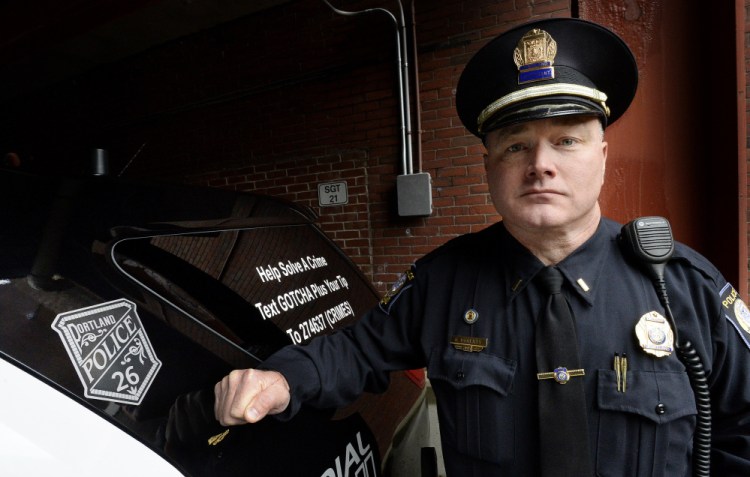Portland police Lt. Robert Doherty comes from a long line of Portland police officers and grew up hearing stories around the dinner table about the department’s early days and larger-than-life figures.
None was more poignant than the story of Officer Charles McIntosh, the first Portland police officer murdered in the line of duty.

The new decal on police cruisers in Portland honor Officer Charles McIntosh who was killed in the line of duty in 1915. Shawn Patrick Ouellette/Staff Photographer
“It’s a big deal to anyone who wears the uniform,” Doherty said. “The police officer in today’s world quite literally puts their life on the line day in and day out and they did 100 years ago, too.”
Wednesday marks the 100th anniversary of McIntosh’s death, and the department is recognizing the date with a memorial decal on its cruisers.
The other Portland officer murdered in the line of duty was Michael T. Connolly, in 1930. His body was found on the Portland waterfront with his hands cuffed behind his back. He had drowned. The case was never solved.
Doherty remembers hearing about McIntosh from his grandfather, Philip McDonough, who was also a Portland officer.
Two burglars who had broken into a Maine Central Railroad station and stolen a handcar were stopped by a railroad detective, but pulled guns on him and fled on foot.
McIntosh and a railroad agent, Edward Winslow, tracked the wanted felons to an area on Outer Washington Avenue.
“Apparently rendered desperate by the closing in of their pursuers, the two men turned about, each hooking out a revolver,” according to an account in the Portland Evening Express and Daily Advertiser on Dec. 17, 1915.
SHOOTOUT IN A FIELD

Charles McIntosh, the first Portland police officer murdered in the line of duty. Courtesy Portland Police Department
The shootout that followed was witnessed by 14-year-old Donald MacDougall, who told the story and later grew up to become a Portland officer, according to a proclamation issued in 1986 by then-Police Chief
Frank Amoroso.
The two lawmen were about 30 feet behind the suspects in a field near a Washington Avenue home when they yelled for them to stop. Instead, the men turned and began shooting. Winslow was killed instantly. McIntosh’s .32 caliber Harrington & Richardson revolver jammed.
“In the old days, Portland officers paid for their own weapons and uniform,” Doherty said. “Now, we are some of the best-trained, best-equipped police officers in the nation, and I’m not so sure they were 100 years ago.”
McIntosh had been hit in the hand and the side, puncturing a lung, but didn’t fall. While the suspects were reloading, he charged at them with his night stick. He knocked one to the ground but the other pulled a fisherman’s knife and stabbed him in the stomach.
“Eyewitnesses to the battle say that the taller of the yeggs (burglars) drew a knife during the exchange of shots and thrust several times into Officer McIntosh’s body and the examination by the medical examiner show that at least one of these thrusts took effect in an ugly wound, which doubtless would have proved fatal in itself,” the Evening Express article said.
A REMINDER OF SACRIFICE
The suspects fled and McIntosh was taken on a sleigh to his house not far away, where he died soon after. The station agent was dead when authorities arrived.
Police captured the two suspects later that day following another shootout near Riverside Street. They were convicted of murder for killing Winslow and McIntosh and sentenced to life in prison.
The department retired McIntosh’s badge number – 26 – in memory of his selfless heroism and devotion to duty, according to the proclamation.
Now, each cruiser and supervisor’s vehicle in the department’s fleet will bear a decal in the shape of an old-style badge with the number 26.
The decals represent an important part of the department’s history and its ethos, Doherty said.
“It’s a reminder that your service and your sacrifice will not be forgotten, has not been forgotten,” he said.
Send questions/comments to the editors.



Success. Please wait for the page to reload. If the page does not reload within 5 seconds, please refresh the page.
Enter your email and password to access comments.
Hi, to comment on stories you must . This profile is in addition to your subscription and website login.
Already have a commenting profile? .
Invalid username/password.
Please check your email to confirm and complete your registration.
Only subscribers are eligible to post comments. Please subscribe or login first for digital access. Here’s why.
Use the form below to reset your password. When you've submitted your account email, we will send an email with a reset code.